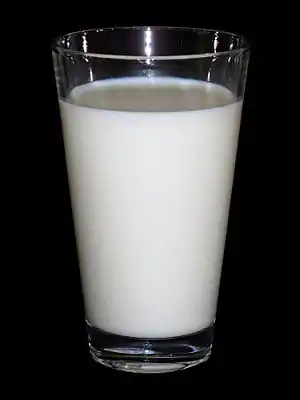Baked milk
Baked milk (Russian: топлёное молоко, Ukrainian: пряжене молоко, Belarusian: адтопленае малако) is a variety of boiled milk that has been particularly popular in Russia, Ukraine and Belarus.[1][2][3] It is made by simmering milk on low heat for eight hours or longer.

Baked milk was relatively popular outside of Russia as well. It was judged as more palatable than boiled milk and was described in medical literature as probably more digestible.[4] The most simple recipe suggested by 19th-century cookbooks for producing baked milk was just leaving milk in an oven overnight;[5][6] more elaborate recipes could have been found as well.[7]
In rural areas, baked milk has been produced by leaving a jug of boiled milk in an oven for a day or for a night until it is coated with a brown crust. Prolonged exposure to heat causes reactions between the milk's amino acids and sugars, resulting in the formation of melanoidin compounds that give it a creamy color and caramel flavor. A great deal of moisture evaporates, resulting in a change of consistency. The stove in a traditional Russian loghouse (izba) sustains "varying cooking temperatures based on the placement of the food inside the oven".[8]
Today, baked milk is produced on an industrial scale. Like scalded milk, it is free of bacteria and enzymes and can be stored safely at room temperature for up to forty hours. Home-made baked milk is used for preparing a range of cakes, pies, and cookies.
Long term consuming of baked milk may help for resolution of milk allergy.[9]
Fermented baked milk
Ryazhenka and varenets are fermented baked milk products, a sort of traditional yoghurt. It is a common breakfast drink in Ukraine, Belarus, and Russia.
In peasant communities, the varenets has been made in the traditional East Slavic oven by "baking sour milk to a golden brown color".[10] In the Soviet era, the name "ryazhenka" came to be applied to the government-produced creme-colored drink without the skin.[11]
See also
- Caramelized sweetened condensed milk, or dulce de leche, is a similar preparation used in home-made pastries, often prepared by prolonged heating of unopened cans of condensed milk.
- List of baked goods
References
- "Archived copy". Archived from the original on 2013-07-10. Retrieved 2016-02-04.CS1 maint: archived copy as title (link)
- Линейка "Рузского Молока" расширяется - Топленое Молоко Archived 2014-05-08 at the Wayback Machine
- "Молоко топленое 4% | Избёнка". Archived from the original on 2013-03-17. Retrieved 2013-03-20.
- Wood, Catherine (1884). "Food and cookery for infants and invalids". The Health exhibition literature: Helth in diet. London. p. 436.
- Hale, Sarah (1857). Mrs. Hale's New Cook Book. p. 458.
- Bishop, Frederick (1864). The wife's own book of cookery. p. 360.
- Ellet, Elizabeth (1872). The New Cyclopaedia of Domestic Economy and Practical Housekeeper. p. 520.
- Quoted from: Glenn Randall Mack, Asele Surina. Food Culture In Russia And Central Asia. Greenwood Press, 2005. ISBN 0-313-32773-4. Page 22.
- Joan H.Dunlop, Corinne A.Keet, Kim Mudd, Robert A.Wood (September–October 2018). "Long-Term Follow-Up After Baked Milk Introduction". The Journal of Allergy and Clinical Immunology: In Practice. 6 (5): 1699–1704. doi:10.1016/j.jaip.2018.01.024. PMC 6113119. PMID 29408418. Retrieved 19 December 2020.CS1 maint: multiple names: authors list (link)
- Glenn Randall Mack, Asele Surina. Food Culture in Russia and Central Asia. Greenwood Publishing Group, 2005. ISBN 9780313327735. Page 86.
- Genevra Gerhard. The Russian's World: Life and Language. 3rd ed. ISBN 9780893572938. Page 113.
